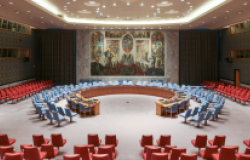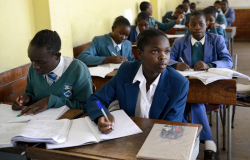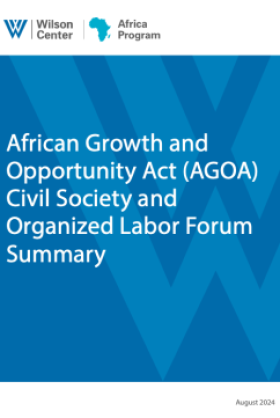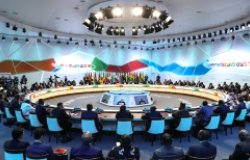Accelerating Action Against Child Labor
Kent Hughes, Director, Program on America and the Global Economy, WWICS; Frank Hagemann, Chief of Policy and Research, ILO International Programme on the Elimination of Child Labor (IPEC); Marcia Eugenio, Director of the Office of Child Labor and Trafficking, DOL/ILAB; Ed Potter, Director of Global Workplace Rights, Coca Cola; Ana Avendano, Special Assistant to the President Richard Trumka, AFL-CIO; Dr. Marty Otañez, Assistant Professor of Political Ecology, Anthropology Department, University of Colorado, Denver
Overview
Moderator:
Kent Hughes, Director, Program on America and the Global Economy, Woodrow Wilson International Center for Scholars
Featuring:
Frank Hagemann, Chief of Policy and Research, ILO International Programme on the Elimination of Child Labor (IPEC)
Marcia Eugenio, Director of the Office of Child Labor and Trafficking, DOL/ILAB
Ed Potter, Director of Global Workplace Rights, Coca Cola
Ana Avendano, Special Assistant to the President Richard Trumka, AFL-CIO
Dr. Marty Otañez, Assistant Professor of Political Ecology, Anthropology Department, University of Colorado, Denver
In 2006, the International Labor Organization (ILO) laid out a Global Action Plan designed to eliminate the worst forms of child labor by 2016. The plan represented the most ambitious agenda since the 1999 ILO Worst Forms of Child Labor Convention 182. Four years later, the ILO's Global Report on Child Labor shows mixed results, calling for renewed action and a reexamination of policy options. On May 25, the Africa Program hosted a roundtable discussion, cosponsored by the American Federation of Teachers, No Limits, the International Labor Rights Forum, and the International Labor Organization, to discuss the latest report released on May 8 in Geneva, and to outline the work that lies ahead.
Uneven Results and a Flattening Curve Frank Hagemann, the Chief of Policy and Research at the ILO's International Programme on the Elimination of Child Labor (IPEC) laid out the main findings of the Global Report on Child Labor. According to the report, child labor has declined since 2000, but is not keeping pace with the goals established in 2006. Particularly troubling is the slowing rate of decline since 2004. "If present trends continue," Hagemann warned, "we will certainly not reach the 2016 goals."
Frank Hagemann, the Chief of Policy and Research at the ILO's International Programme on the Elimination of Child Labor (IPEC) laid out the main findings of the Global Report on Child Labor. According to the report, child labor has declined since 2000, but is not keeping pace with the goals established in 2006. Particularly troubling is the slowing rate of decline since 2004. "If present trends continue," Hagemann warned, "we will certainly not reach the 2016 goals."
Widening gaps in gender, age groups, and regions further complicate the picture. While girls have steadily dropped out the workforce since 2000, employment of boys increased in 2004-2008. Likewise, progress has been concentrated in the 5-14 age group, while employment of 15-17 year-olds increased by 20% in 2004-2008. Sub-Saharan Africa is the only region where child labor has increased since 2000.
Bringing Child Labor out of the Niche
We must "bring child labor and action against child labor out of the niche and bring it to the forefront of economic and social development," Hagemann argued. To do so, development agendas should include universal education, a "basic social protection floor," and "productive employment for parents." The report argues that increased human capital resulting from the elimination of child labor far outweigh the economic costs of removing children from the workforce.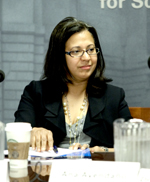 "We have learned that a shared commitment to a niche is not enough," Marcia Eugenio affirmed. As Director of the Office of Child Labor, Forced Labor, and Human Trafficking in the Bureau of International Labor Affairs (ILAB), Eugenio pointed to the 1.3 million children ILAB has helped to elevate out of child labor, but was troubled by those groups whose condition has not improved. While the decrease in female child labor is a success in light of the ILO convention 182's emphasis on girls, it was not intended to exclude others from protection.
"We have learned that a shared commitment to a niche is not enough," Marcia Eugenio affirmed. As Director of the Office of Child Labor, Forced Labor, and Human Trafficking in the Bureau of International Labor Affairs (ILAB), Eugenio pointed to the 1.3 million children ILAB has helped to elevate out of child labor, but was troubled by those groups whose condition has not improved. While the decrease in female child labor is a success in light of the ILO convention 182's emphasis on girls, it was not intended to exclude others from protection.
Creating a Social Movement
"Who are the beneficiaries?" Dr. Marty Otañez, Assistant Professor of Political Ecology at the University of Colorado, asked. According to his research, the tobacco industry reaps $1.2 billion in benefits from unpaid child labor each year. Comparing this against the $22 million the tobacco industry spends on social projects, Otañez argued that some fundamental aspects of the global system of capitalism should be reexamined. Drawing on his involvement as an organizer, Otañez suggested building "ground-level" enforcement mechanisms, and publicizing anecdotal evidence of child labor through the production of "digital stories" to rally people around a social movement against child labor. Ed Potter, the Coca-Cola Company's Director of Global Workplace Rights, took some in the audience by surprise by joining Otañez's call. Using Professor John Ruggie's formula for Corporate Social Responsibility, "Protect and Respect," Potter argued that a social movement is necessary to enforce the protection of the ILO conventions. Working in eight countries, Coca-Cola has attempted to mobilize the sugar industry to enforce child labor bans. Potter cited El Salvador as a success story where a surprise audit system run by the sugar industry has cut child labor in half to 5,000 children. However, Potter concluded, "in the end, it comes down to poverty…but this is not something that the Coca-Cola industry can solve, it really requires a movement."
Ana Avendaño, Assistant to the President and Director of Immigration and Community Action at the AFL-CIO, argued that "to protect workers rights, what we really have to do is find that intersection between social movement building and institutional building." Trade unions, she argued, have the experience to organize informal labor markets, especially prone to child labor, and to advocate for social protection.
The Work Ahead
Doubts raised about the statistical visibility of certain forms of child labor including human trafficking and domestic workers notwithstanding, panel members and attendees generally agreed that the report offers a solid set of bench marks to measure the struggle against child labor. As the 2016 deadline approaches, it seems unlikely that the original goals will be met, but some expressed optimism that "the political stars are aligned" for decisive action. There was broad consensus for Potter's assessment that poverty is the root cause of child labor. However, the ILO's position that eliminating child labor is economically advantageous opens the door to a development program that integrates the elimination of child labor rather than direct poverty eradication as a central economic policy.
By Paul Diegert, Intern, and Justine Lindemann, Program Assistant
Steve McDonald, Consulting Director, Africa Program
Download the 2010 Global Report (pdf).
Hosted By

Africa Program
The Africa Program works to address the most critical issues facing Africa and US-Africa relations, build mutually beneficial US-Africa relations, and enhance knowledge and understanding about Africa in the United States. The Program achieves its mission through in-depth research and analyses, public discussion, working groups, and briefings that bring together policymakers, practitioners, and subject matter experts to analyze and offer practical options for tackling key challenges in Africa and in US-Africa relations. Read more
Thank you for your interest in this event. Please send any feedback or questions to our Events staff.




